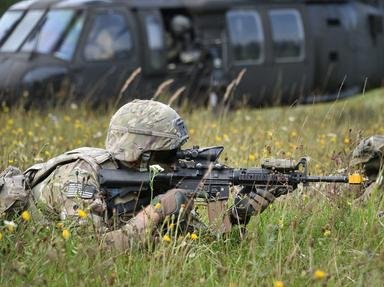Quiz Answer Key and Fun Facts
1. This simple epaulette belongs to an enlisted soldier. The three diagonal bars represent the rank of Hauptgefreiter (Private First Class), but what does the single horizontal one on top of them stand for?
(Note: The insignia is rotated for better screen presentation, the official presentation has the rounded part at the top)
2. This insignia is also an uncommon sight, showing the last officer cadet rank before receiving a commission, equivalent to a sergeant 1st class in the US army. It combined the silver-bordered officer's epaulette with a braid-shaped insignia. The latter symbol resembles an old Germanic rune, but what does it represent in rank order?
3. How about an even rarer insignia? The one shown in this picture is usually unique - only one officer at a time will normally hold this rank. It is the equivalent of a one-star general for a specific medical specialty, but which one?
4. Now for something entirely different. This shoulder cord (worn on the right side) may only be worn by enlisted and NCO personnel, but not by officers although officers can earn it - what is it given for?
5. This insignia, worn on the left chest pocket, is a really common sight - most soldiers will earn at least the bronze level. It is awarded for military proficiency and requires a soldier to pass multiple tests. Which of these is NOT included?
6. These insignia look similar to the ones in the previous question, but are rather just service branch insignia worn on which part of the uniform?
7. Of all the insignia in this quiz, this "coat of arms" has the most variety and color. Every soldier wears only one of these, on the upper left arm. They represent the unit the soldier is serving in, usually distinguishable down to what level?
8. This is an older version of a prestigious and hard to earn insignia called "Einzelkämpferabzeichen". What would be the English name for this kind of soldier?
9. These insignia are worn on the collar of the dress uniform. Apart from the generals' versions (top right), the design only subtly varies by rank. However, as you can see, they come in a variety of colors, denoting what?
10. Similar to service branches, these badges reflect a soldier's function and service at an individual level. Up to two of these may be worn, but what determines whether the award is worn with a gold, silver or bronze center symbol?
Source: Author
WesleyCrusher
This quiz was reviewed by FunTrivia editor
stedman before going online.
Any errors found in FunTrivia content are routinely corrected through our feedback system.
